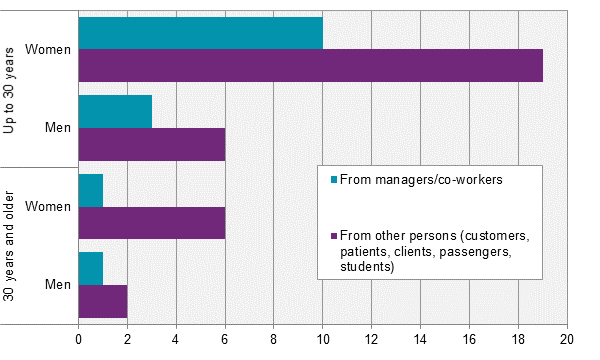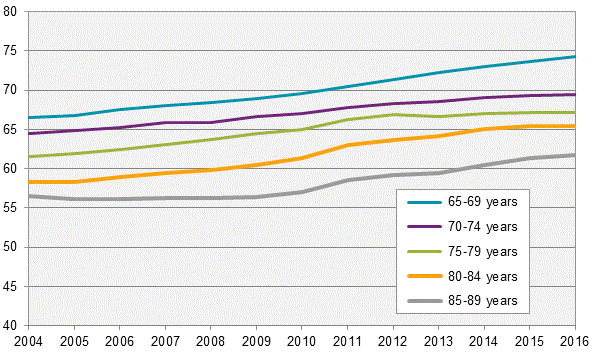Women and men in Sweden. Facts and figures 2018:
Gender inequality from school to retirement
Statistical news from Statistics Sweden 2018-06-28 7.00
Women have a higher educational level than men. In spite of this, women have lower salaries, lower incomes and, eventually, lower pensions than men. Statistics also show that women worry more, perceive their health to be worse and feel more stressed than men already in school. These are but a few items you can read about in “Women and men in Sweden 2018”, which is being published today.
The educational level is rising for both women and men, but it rises more for women than for men. Women have better grades than men, both in year 9 and in upper secondary school. At the same time, 30 percent of girls aged 12–15 feel stressed due to homework or exams, compared with 16 percent of boys. This stress increases with age. In the ages 16–18, more than every second girl and nearly every third boy feels stressed due to homework or exams.
| Age | Number of | Often feel stressed due to homework or exams. Proportion (%) | ||
|---|---|---|---|---|
| Girls | Boys | Girls | Boys | |
| 12–15 | 208 700 | 221 300 | 30 | 16 |
| 16–18 | 150 000 | 163 600 | 54 | 27 |
| Total | 358 700 | 385 000 | 40 | 21 |
Source: Living Conditions Survey of Children, Statistics Sweden
Preparatory programmes for post-secondary education are more common among pupils with a foreign background
Women and men chose different programmes in upper secondary school. Women are more likely than men to choose a preparatory programme for post-secondary education. The higher the educational level of the parents, the higher the proportion of both women and men who choose a preparatory programme for post-secondary education. Also, pupils with a foreign background are more likely to choose such a program than pupils with a Swedish background.
The proportion of women attending male-dominated programmes is increasing
More women than men attend higher education. In 2017, 64 percent of all degrees were obtained by women and 36 percent were obtained by men. Natural science, mathematics and computer technology is the only field with an even sex distribution. One field, technology and manufacturing, is dominated by men; the remaining fields are mostly attended by women. However, women have increased their proportion of degrees within technology and manufacturing from 10 to 35 percent from the 1970s.
Men perceive their health to be better than women
Men are more likely than women to perceive that they have good health, and younger persons are more likely than older persons to feel that their health is good. At 23 percent, the proportion who perceive that they have poor health is higher among women whose educational level is compulsory school or lower, compared with 9 percent of men.
Foreign-born women have the lowest employment rate
From an international perspective, Sweden has a high employment rate among women as well as men. There is a major difference, however, between those born in Sweden and those born in another country. The difference is greatest among women; 87 percent of women born in Sweden are employed, compared with 67 percent of foreign-born women. The employment rate is 89 percent for men born in Sweden and 76 percent for men born outside Sweden.
Unemployment is highest for foreign-born women with an educational level of compulsory school or lower
Employment is highest among those with a post-secondary education and lowest among those whose educational level is compulsory school or lower, regardless of whether they are born in Sweden or abroad. The same applies to unemployment. It is higher among those who are born abroad and whose educational level is compulsory school or lower. In this group, 32.5 per cent of women and 25.9 percent of men are unemployed.
Young women are subjected to sexual harassment in the workplace
It is most common for women below the age of 30 to be subjected to sexual harassment in the workplace. One in ten women below the age of 30 state that they have been subjected at least once in the last 12 months by managers or colleagues, and one in five state that they have been subjected at least once in the last 12 months by other people.
Proportion (%) of all employed persons

Percent

Source: Income and tax register, Statistics Sweden
Lower pensions for women
Women still have lower average salaries than men, even if the difference has decreased somewhat.
'The difference in salaries is largely due to the fact that women and men work in different occupations and sectors. When occupation, education, age, working hours and sector are considered, women are paid 95 percent of men’s salaries.
Women work part time more often than men, take more paid parental leave, care more often for sick children and have a higher number of sick days. This leads to a lower income than men, which also leads to a lower pension at the end of their working lives. On average, women have 68 percent of men’s pensions, and this difference increases by age.
Publication
“Women and men in Sweden” was first published in 1984 and is published every other year in Swedish and in English. The booklet presents statistics on the terms for women and men in Sweden within many areas.
The full publication is available on Statistics Sweden’s website.
Feel free to use the facts from this statistical news but remember to state Source: Statistics Sweden.
